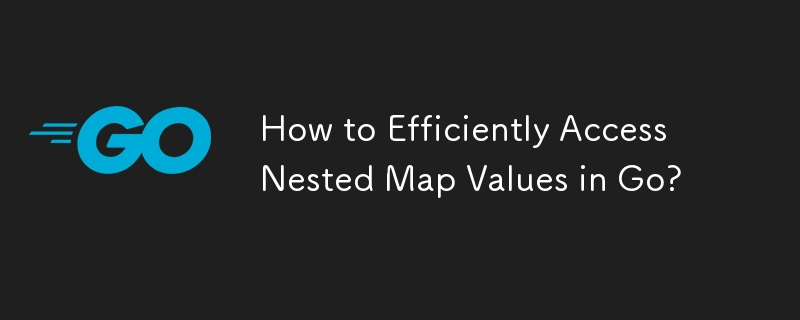How to Efficiently Access Nested Map Values in Go?

Getting Values from Nested Maps: A Comprehensive Guide in Go
When dealing with complex data structures like nested maps, accessing nested values can prove to be a challenge. This question explores a common scenario where you're trying to retrieve values from deeply nested maps in Go. Let's delve into the problem and provide a detailed solution.
The Problem:
In the provided code snippet, you have a complex nested map structure:
m := map[string]interface{}{
"date": "created",
"clientName": "data.user.name",
"address": map[string]interface{}{
"street": "x.address",
},
"other": map[string]interface{}{
"google": map[string]interface{}{
"value": map[string]interface{}{
"x": "y.address",
},
},
},
"new_address": map[string]interface{}{
"address": "z.address",
},
}You're trying to access and print the values from this nested map, particularly the ones within the "other" and "new_address" submaps. How can you achieve this in an efficient and clean way?
The Solution:
The solution lies in nonpanic casting, which allows you to convert an interface{} value to a specific type safely. In this case, you need to cast each map value to a map[string]interface{} to access the underlying values. Here's the updated code:
for i := range m {
nestedMap, ok := m[i].(map[string]interface{})
if ok {
// Do what you want with the nested map
fmt.Println(nestedMap)
}
}Explanation:
The code iterates over the map's keys and for each value at key i, it attempts to cast it to map[string]interface{} using a type assertion. If the cast succeeds (indicated by the boolean ok being true), it means the value is a nested map. You can then work with this nested map as needed, accessing its values and performing further operations.
Additional Resources:
For more information on nonpanic casting in Go, refer to the official documentation: https://golang.org/ref/spec#Type_assertions
The above is the detailed content of How to Efficiently Access Nested Map Values in Go?. For more information, please follow other related articles on the PHP Chinese website!

Hot AI Tools

Undresser.AI Undress
AI-powered app for creating realistic nude photos

AI Clothes Remover
Online AI tool for removing clothes from photos.

Undress AI Tool
Undress images for free

Clothoff.io
AI clothes remover

Video Face Swap
Swap faces in any video effortlessly with our completely free AI face swap tool!

Hot Article

Hot Tools

Notepad++7.3.1
Easy-to-use and free code editor

SublimeText3 Chinese version
Chinese version, very easy to use

Zend Studio 13.0.1
Powerful PHP integrated development environment

Dreamweaver CS6
Visual web development tools

SublimeText3 Mac version
God-level code editing software (SublimeText3)

Hot Topics
 What are the vulnerabilities of Debian OpenSSL
Apr 02, 2025 am 07:30 AM
What are the vulnerabilities of Debian OpenSSL
Apr 02, 2025 am 07:30 AM
OpenSSL, as an open source library widely used in secure communications, provides encryption algorithms, keys and certificate management functions. However, there are some known security vulnerabilities in its historical version, some of which are extremely harmful. This article will focus on common vulnerabilities and response measures for OpenSSL in Debian systems. DebianOpenSSL known vulnerabilities: OpenSSL has experienced several serious vulnerabilities, such as: Heart Bleeding Vulnerability (CVE-2014-0160): This vulnerability affects OpenSSL 1.0.1 to 1.0.1f and 1.0.2 to 1.0.2 beta versions. An attacker can use this vulnerability to unauthorized read sensitive information on the server, including encryption keys, etc.
 Transforming from front-end to back-end development, is it more promising to learn Java or Golang?
Apr 02, 2025 am 09:12 AM
Transforming from front-end to back-end development, is it more promising to learn Java or Golang?
Apr 02, 2025 am 09:12 AM
Backend learning path: The exploration journey from front-end to back-end As a back-end beginner who transforms from front-end development, you already have the foundation of nodejs,...
 What libraries are used for floating point number operations in Go?
Apr 02, 2025 pm 02:06 PM
What libraries are used for floating point number operations in Go?
Apr 02, 2025 pm 02:06 PM
The library used for floating-point number operation in Go language introduces how to ensure the accuracy is...
 What is the problem with Queue thread in Go's crawler Colly?
Apr 02, 2025 pm 02:09 PM
What is the problem with Queue thread in Go's crawler Colly?
Apr 02, 2025 pm 02:09 PM
Queue threading problem in Go crawler Colly explores the problem of using the Colly crawler library in Go language, developers often encounter problems with threads and request queues. �...
 How to specify the database associated with the model in Beego ORM?
Apr 02, 2025 pm 03:54 PM
How to specify the database associated with the model in Beego ORM?
Apr 02, 2025 pm 03:54 PM
Under the BeegoORM framework, how to specify the database associated with the model? Many Beego projects require multiple databases to be operated simultaneously. When using Beego...
 In Go, why does printing strings with Println and string() functions have different effects?
Apr 02, 2025 pm 02:03 PM
In Go, why does printing strings with Println and string() functions have different effects?
Apr 02, 2025 pm 02:03 PM
The difference between string printing in Go language: The difference in the effect of using Println and string() functions is in Go...
 How to solve the user_id type conversion problem when using Redis Stream to implement message queues in Go language?
Apr 02, 2025 pm 04:54 PM
How to solve the user_id type conversion problem when using Redis Stream to implement message queues in Go language?
Apr 02, 2025 pm 04:54 PM
The problem of using RedisStream to implement message queues in Go language is using Go language and Redis...
 What should I do if the custom structure labels in GoLand are not displayed?
Apr 02, 2025 pm 05:09 PM
What should I do if the custom structure labels in GoLand are not displayed?
Apr 02, 2025 pm 05:09 PM
What should I do if the custom structure labels in GoLand are not displayed? When using GoLand for Go language development, many developers will encounter custom structure tags...






